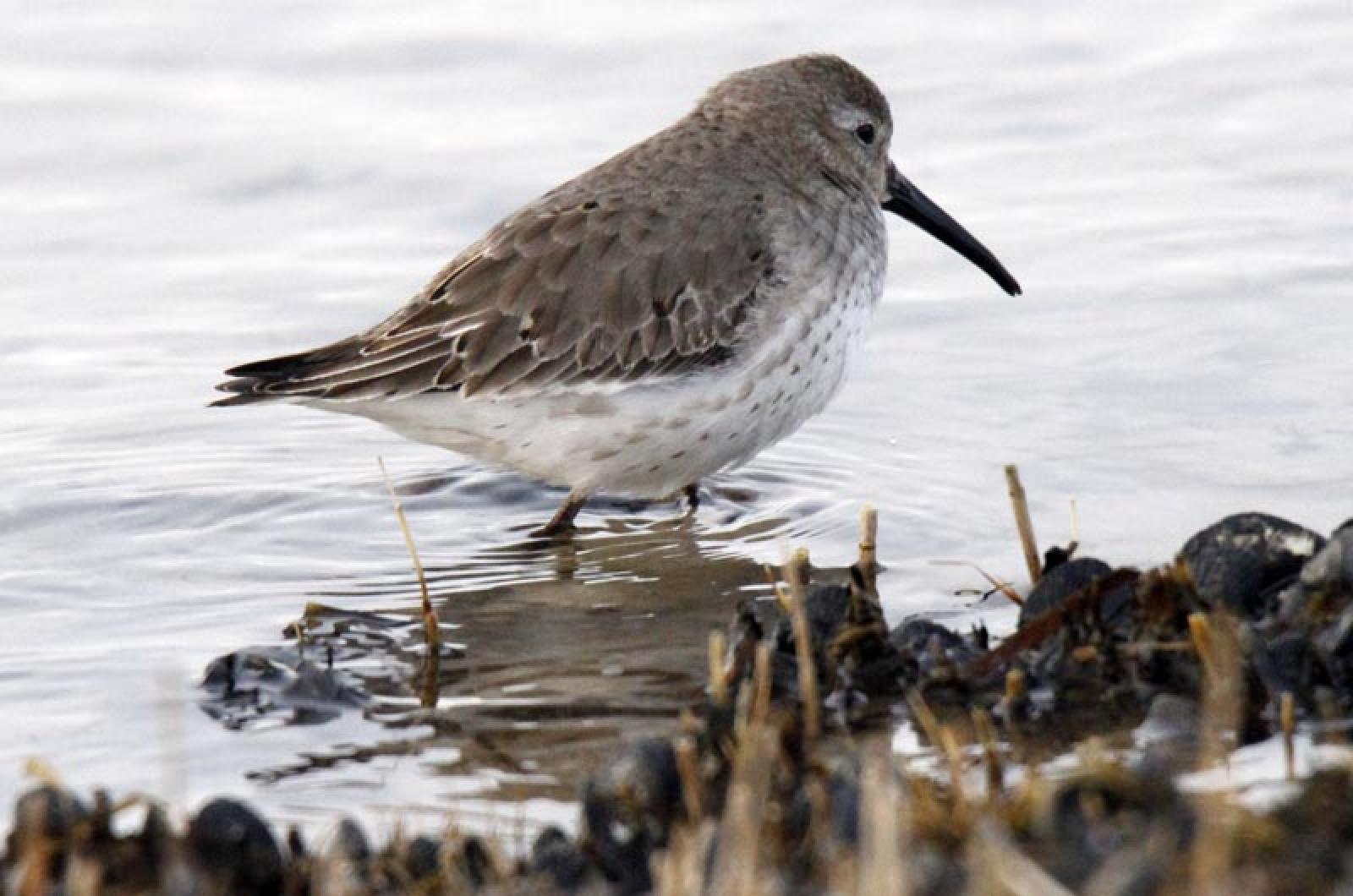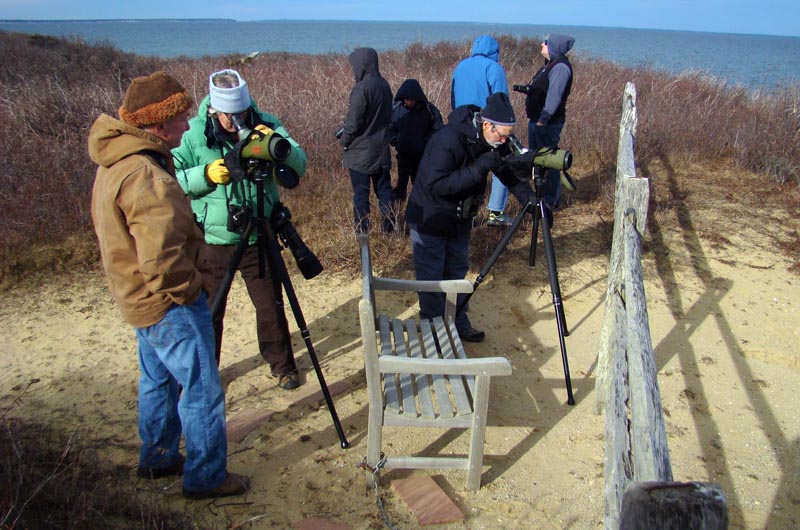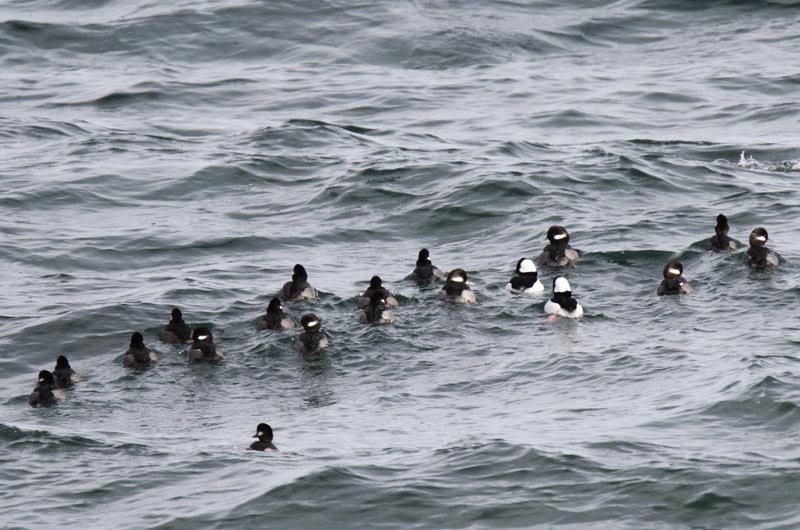Just before dawn on Saturday, a small group of birders stood in the dark at the Long Point Wildlife Refuge in Edgartown and listened for a response to their recorded call of a screech owl. After a few moments, they heard a soft hooting from the trees in the distance — enough to confirm the species — and continued on their way.
The 55th annual Christmas Bird Count came on the heels of a small snowstorm, and many birds were lying low throughout the day. But 12 groups that were assigned to areas around the Island observed more than 28,000 birds, including 120 species and two subspecies, according to the preliminary tally on Saturday.
If confirmed, a rare spotted towhee seen near Squibnocket Beach would mark the 214th species observed since the counts in their current form began in 1960. Other highlights this year included a merlin (a small species of falcon) and a rare gallinule (a colorful bird also known as a marsh hen), both spotted at the head of Lagoon Pond in Oak Bluffs; two white-crowned sparrows on Chappaquiddick; and a record count of 199 tufted titmice Island-wide.
At Long Point on Saturday, the birders collected their telescopes, binoculars, cameras and other gear from their cars and headed into the preserve, where they observed bufflehead, common goldeneye, a northern harrier hawk and other species feeding on Long Cove Pond.
On the Island shores, birders looked for sea birds heading back out to deeper water in the early light.
Sharon Simonin was among those in the Long Point group who hoped to see a snowy owl, since she had seen one on State Beach around Thanksgiving. “It stood out like a sore thumb because it’s so bright white against the ground,” she said.
Only three snowy owls were spotted on Saturday — far fewer than were seen last year, when conditions in the arctic had forced many of the owls farther south.
About 35 birders from on and off the Island took part in the daylong event, which has its roots in the resident bird counts that began in the early 1900s. Those counts were intended to monitor only the Island’s year-round bird population, since migrant birds usually leave during the winter. Now birders try to find as many species as possible.
Chris Neill, director of the ecosystems center at the Marine Biological Laboratory in Woods Hole, was in the group covering Oak Bluffs. “We are always looking for unusual stuff just because it’s fun,” he said. But he added that the counts have “been very valuable in understanding some kinds of changes to bird populations.” He noted that the tufted titmouse, which is common on the Cape, didn’t begin colonizing the Vineyard until about 15 years ago.
Wayne Klockner, state director of the Nature Conservancy, who also joined the Oak Bluffs group, said monitoring the same areas every year provided valuable data on winter bird populations. “It’s not an exact count but it’s a good index of which species are getting more common in a certain area or getting less common,” he said.
The final numbers are added to a database at the National Audubon Society.
Many southern species, including the Carolina wren and red-bellied woodpecker, and more recently the fish crow, have moved north as a result of climate change, Mr. Neill said. “And this is a way of documenting that occurrence.”
The leader of the Oak Bluffs group, Tom Chase, added that there were other factors besides climate change at work, such as the abundance of bird feeders at private homes. (Birds found at feeders Saturday were tallied separately.)
“There are a lot of warblers around that should be in Central America or South America right now,” said Keenan Yakola, who had travelled from the Cape with two friends (one from Vermont) and was in the Long Point group. He said the warmer weather this year has caused some species to linger, creating more opportunities for birders.
Even though it is near a main road and is surrounded by houses, the head of Lagoon Pond in Oak Bluffs is considered one of the hotspots for birding in the winter. Mr. Neill said birds are drawn to the area because enough water flows through to delay the freezing of the pond. Mallards, mute swans and other species were observed on the water, along with some less common species: black-crowned night heron, American coot, belted kingfisher and American widgeon.
The group walked along a path by the water, stopping to look for winter wren and other small land birds. Some members of the group made raspy noises (a trick known as pishing) and other calls to arouse the curiosity of the birds. Without the protection of foliage, the birds were easier to spot, along with their nests from last year, but still the numbers were low.
Longtime birders joked with each other and shared a sense of camaraderie. Mr. Chase said that a core group of six or eight people had been covering the same areas in Oak Bluffs for decades. At the end of the morning, the group posed near the pond for its first-ever group photo. Then it headed to its traditional mid-morning breakfast at Linda Jean’s.
Despite the rare sightings this year and the new record for tufted titmouse, birders were surprised by the low overall count, which they attributed to the weather. “It was a relatively pleasant day for humans but there was no sun,” Mr. Chase said.
“Due to the coming storm, [the birds] just find a protected spot and get out of the way,” said Robert Culbert, who led the Long Point group and was also the general compiler for the evening tally.
“They were really hard to find,” said Luanne Johnson, director of BiodiversityWorks in Tisbury, which monitors many of the Island’s shorebird nesting sites in the spring and summer. “You could go to thickets and the thickets were just quiet, where normally you are hearing little chips and little calls. And everybody else said the same thing . . . It was just quiet.”
People drove through the first snowfall of the year to attend the tally at the Wakeman Center in Tisbury on Saturday evening. Lasagna and soup were waiting for them when they arrived. Groups sat at two long tables and called off their counts for each of 213 species, 120 of which were reported, although not all sightings have been confirmed.
At the beginning of the tally, Mr. Culbert offered a moment in recognition of longtime birder and Island resident Tom Rivers, who died on New Year’s Day. “He took part in the count every year and he is going to be missed,” he said.
Mr. Culbert plans to work with Island high school students to further analyze the data in terms of how it relates to changes in the overall bird populations. He expected a public presentation to take place in June. A final tally will be likely ready by late January.











Comments (2)
Comments
Comment policy »